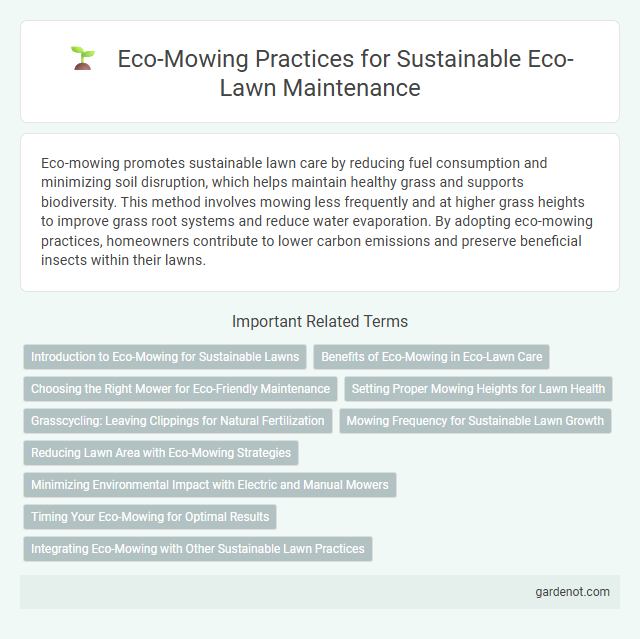Eco-mowing promotes sustainable lawn care by reducing fuel consumption and minimizing soil disruption, which helps maintain healthy grass and supports biodiversity. This method involves mowing less frequently and at higher grass heights to improve grass root systems and reduce water evaporation. By adopting eco-mowing practices, homeowners contribute to lower carbon emissions and preserve beneficial insects within their lawns.
Introduction to Eco-Mowing for Sustainable Lawns
Eco-mowing promotes sustainable lawns by reducing environmental impact through lower mowing frequency, higher cutting heights, and leaving grass clippings on the lawn to retain nutrients. This method supports biodiversity, improves soil health, and conserves water by maintaining a thicker, healthier turf. Adopting eco-mowing practices enhances lawn resilience against pests and drought while minimizing the need for chemical inputs.
Benefits of Eco-Mowing in Eco-Lawn Care
Eco-mowing reduces grass height strategically to promote deeper root growth and enhance drought resistance in eco-lawns, leading to healthier turf with less water dependency. This sustainable practice minimizes soil compaction and supports biodiversity by encouraging beneficial insects and microorganisms. Its benefits include improved soil quality, reduced chemical use, and lower maintenance costs, contributing to environmentally friendly lawn care.
Choosing the Right Mower for Eco-Friendly Maintenance
Selecting the right mower for eco-friendly lawn maintenance involves prioritizing electric or battery-powered models that reduce carbon emissions and noise pollution. Reel mowers provide a chemical-free, energy-efficient alternative ideal for small to medium lawns, promoting healthier grass growth. Opt for mowers with adjustable cutting heights to support natural grass variability and enhance biodiversity in an eco-lawn ecosystem.
Setting Proper Mowing Heights for Lawn Health
Setting proper mowing heights is essential for promoting eco-lawn health by enhancing root development and increasing drought resistance. Maintaining grass at the recommended height reduces stress on turf, minimizes weed invasion, and supports beneficial microbial activity in the soil. Optimal mowing heights vary by grass species but typically range from 2.5 to 3.5 inches to balance photosynthesis efficiency and water retention.
Grasscycling: Leaving Clippings for Natural Fertilization
Grasscycling involves leaving grass clippings on the lawn after mowing to promote natural fertilization and moisture retention. This eco-mowing practice reduces the need for chemical fertilizers by recycling nutrients like nitrogen and phosphorus directly back into the soil. Regular grasscycling supports sustainable lawn care by improving soil health and encouraging robust turf growth.
Mowing Frequency for Sustainable Lawn Growth
Eco-mowing emphasizes reduced mowing frequency to promote sustainable lawn growth by allowing grass to develop deeper root systems and improved drought resistance. Mowing once every 10 to 14 days helps maintain optimal grass height, enhancing nutrient absorption and minimizing stress on the lawn ecosystem. This practice supports biodiversity and reduces fuel consumption, contributing to an environmentally friendly lawn care routine.
Reducing Lawn Area with Eco-Mowing Strategies
Eco-mowing strategies reduce lawn area by promoting native grasses and ground covers that require less water and maintenance, enhancing biodiversity and soil health. Implementing targeted mowing patterns preserves flowering plants and habitat areas, supporting pollinators and wildlife. These practices lower carbon emissions and reduce the need for chemical fertilizers and pesticides, contributing to sustainable landscape management.
Minimizing Environmental Impact with Electric and Manual Mowers
Eco-mowing reduces carbon emissions and noise pollution by using electric and manual mowers, which require less energy than traditional gas-powered equipment. Electric mowers eliminate harmful fossil fuel combustion, promoting cleaner air quality and healthier ecosystems. Manual reel mowers further minimize environmental impact by producing zero emissions and preserving soil health during lawn maintenance.
Timing Your Eco-Mowing for Optimal Results
Timing your eco-mowing during early morning or late afternoon reduces plant stress and conserves moisture, promoting healthier grass growth. Mowing when the grass is dry minimizes disease risk and ensures cleaner cuts, improving lawn resilience. Regularly adjusting mower height according to seasonal growth patterns supports biodiversity and reduces the need for chemical interventions.
Integrating Eco-Mowing with Other Sustainable Lawn Practices
Integrating eco-mowing with sustainable lawn practices enhances biodiversity and reduces environmental impact by minimizing fuel consumption and preserving native plant species. Practices such as composting grass clippings, reducing chemical fertilizers, and promoting drought-resistant grasses complement eco-mowing techniques to improve soil health and water conservation. Together, these methods create resilient, low-maintenance lawns that support local ecosystems and reduce carbon footprints.
Eco-mowing Infographic

 gardenot.com
gardenot.com